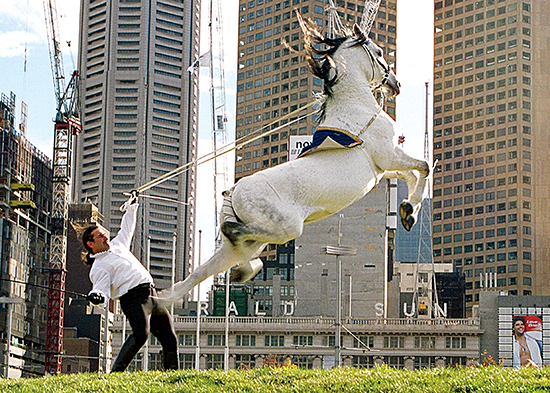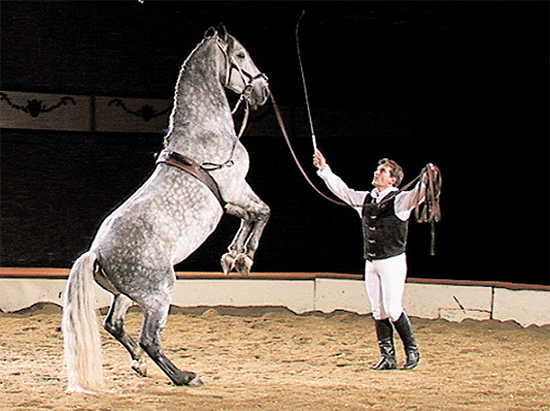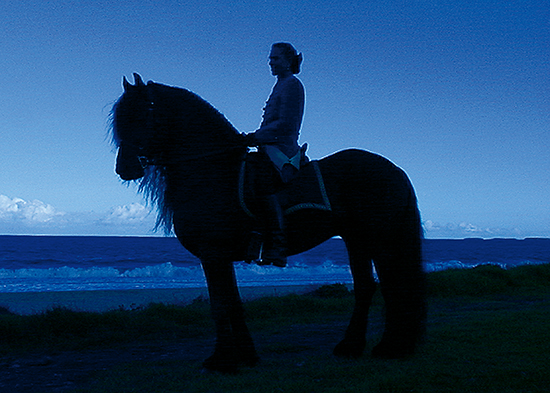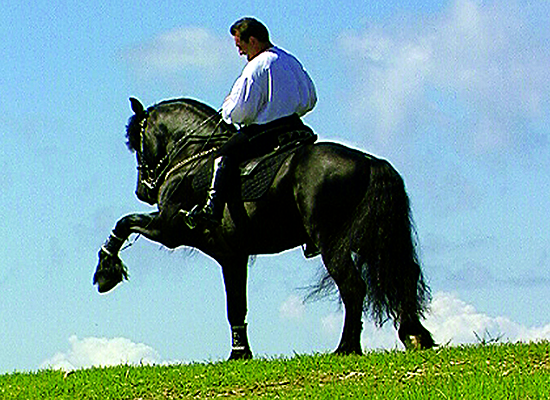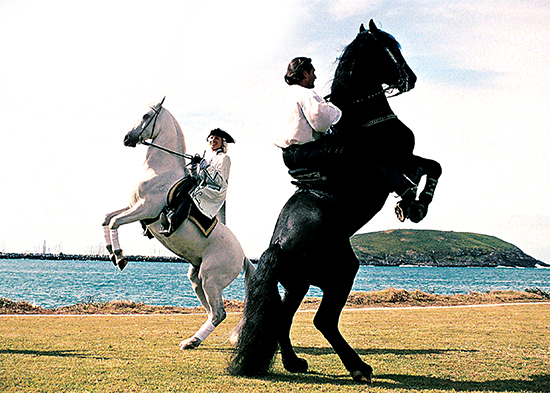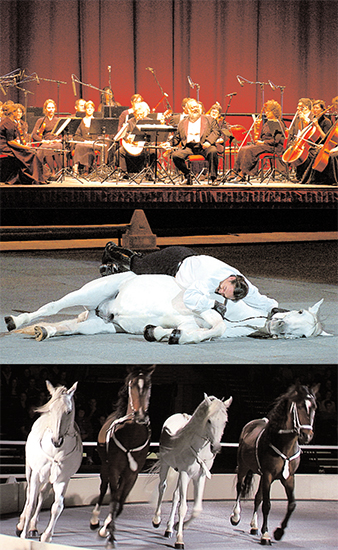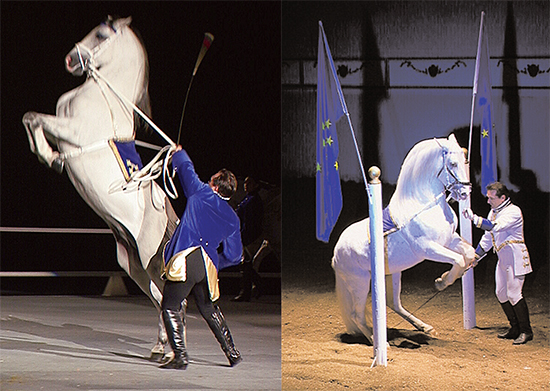 Written by Andrew Lindsay and photographed by David Gillson, Jann Hott and Andrew Lindsay
Written by Andrew Lindsay and photographed by David Gillson, Jann Hott and Andrew Lindsay
In the stables backstage, I quickly swapped my horse’s gear and made final adjustments to my tack. I was already in costume but had left it a little too late to get my horse ready and now my act was next. I could hear the clear voice of soprano singer, Merlyn Quaffe rising above the Mozart Symphony Orchestra playing Mozart’s aria, ‘Queen of the Night’ and I knew I had to hurry.
This was the opening night of ‘Lipizzaners with the Stars’ the second major equestrian production of Rene Gasser’s to tour Australia. Melbourne, as the cultural heart of Australia and the most European of Australian cities, seemed the fitting choice for the opening performance of a show based on the finest European traditions of classical music and classical horsemanship.
The equestrian component of the production was fashioned in the spirit of the various classical schools of Europe. ‘Lipizzaners with the Stars’ was unique, however, in that the beautiful baroque stallions were accompanied in their four footed ballet by a live thirty piece orchestra and a world renowned opera singer.
Something like this, so far as we knew, had never been done before. There are many horse shows that tour the world, some following in the tradition of the great classical centres of Vienna, Saumur and Jerez, and some of a more inventive nature, but unfortunately not many reach Terre Australis. Our isolation prevents us from witnessing first hand much of the equestrian magnificence that is so large a part of European tradition. It is therefore a rare treat for Australians to witness a performance like Rene’s display of “the pomp and grandeur of the baroque era”.
The Lipizzaner Stallion- Neapolitano Steaka I, or Stephan as he is known around the stables, was almost ready as I led him to the area behind the curtain. He was my partner in training and performing for this show. More than that, I considered him my friend and despite his vicious look and attempt to bite me as I tightened the girth, I am sure the sentiment was reciprocated.
I sprung aboard the soft grey Spanish saddle on his back and lined up behind the other two horses. Their riders, Sarah Evens and Michi Zink glanced back and we exchanged smiles and good lucks. They at least smiled, I felt sick with nerves. I did my best not to let the horse beneath me feel it, though of course he could. Older hands than I at this performing game, the girls were either not nervous or better at hiding it than me. They casually exchanged banter with Rene, better known as ‘Sonny’ to those who know him well, and remarked on the roll up of the crowd.
Looking at Rene, one can better picture him as a circus strongman or a lion tamer, as indeed he was, than a trainer of classical dressage. Defying the image of the long legged lanky rider, he is stocky and muscular, and in his younger years could have held his own on the pages of many a bodybuilding magazine. At forty three, he still carries himself well and with his enigmatic character casts an imposing figure. When Rene says something must be done, it is done.
The Gassers are an old Swiss circus family. When Rene was born, he inherited seven generations of circus tradition. This inheritance led him to a life’s experience in performing and showmanship. His career as a lion trainer, acrobat, gymnast, and strongman as well as horse trainer took him to Switzerland, Germany, Israel, Ireland and Japan. When Rene emigrated from Switzerland with his parents and sisters, they developed Circus Sonelli and with it, followed the well worn Australian circus circuit. However, life was tough on the road.
“Circus is a dying form of entertainment”, Rene often told me. “In the old days of the grand circuses, before TV and video games, circus was the only entertainment. Now it just isn’t cool anymore.”
So, when the circus closed, he began seriously working towards his dream of an equestrian spectacular. However, this dream may not have been realised if not for the experience he gained in the circus. Indeed some of the very acts and horses that would star in his later equestrian productions, Rene originally trained for Circus Sonnelli.
The survival and development of dressage and horsemanship is due, in part, to the prominence of horse acts in circuses, especially the grand circuses of the 18th and 19th centuries. As well as trick riding, vaulting, liberty training and Roman riding (where the rider stands on the backs of two galloping horses side by side), the lessons of the Haute École, or high school were taught and became highlight performances in the great circuses of Europe.
My thoughts were disturbed, the curtains suddenly opened and we were filing out onto the rubber matting floor of the arena. So this was it. For this we had been training for the past year. This was the ‘Airs above the Ground’ such as is performed in the hallowed riding halls of Vienna and Spain, and the circuses of old.
Traditionally, the ‘Airs’ consist of: the levade, where the horse raises the forelegs off the ground and balances his weight over deeply bent hind quarters; the courbette, in which the horse rears and jumps forward several times on his hind legs while maintaining a collected frame; and the capriole, considered the most difficult of the airs where the horse leaps into the air and at maximum height, kicks out with the hind legs. Although most commonly performed ‘in hand’ with the trainer on the ground controlling the horse via long reins, we were performing the airs under saddle.
In days past this was practiced in classical schools but is becoming less common due to the difficulty of the movements. Indeed, it in was intended that Stephan’s full brother Styria would perform the capriole under saddle. Unfortunately it had not come together by show day, so Rene replaced him in the show with the Friesian stallion Apollo. As a safer but no less spectacular option, Apollo would perform a ‘pirouette at the pesade’ (a pirouette while rearing on his hind legs). Stephan and I were to perform the courbette and I considered this challenging enough for me.
“We’ll just take what he gives us to start with, we won’t push him too hard,” Rene whispered as I passed him on my way towards the arena. I nodded and as the spotlight and the attention of three thousand faces fell on us, applause erupted in the audience. All trace of nerves left me, and I was all concentration on the fluid steps of the horse beneath me and the task ahead…
When I first heard of Rene Gasser and his troupe of equine performers, I was working in Sydney, riding racehorses at a pre-training barn. He was soon coming to Sydney with his first major production “Gala of the Royal Horses”, a patchwork of equine artistry including circus acts, classical dressage and theatre. The show was heavily advertised in horsy magazines but, as I couldn’t afford to see it at the time, I had to be content to gaze at the beautiful magazine images and dream. What an experience it would be to travel the country performing with these magnificent creatures and learn the art of classical dressage!
The lure and magic of the horse is a curious thing and can only be fully understood by those who have succumbed to it. But to me, a lover of history and culture as well as all things horsy, classical dressage and the baroque horses who perform it are the pinnacle of equestrian art, beauty and elegance.
Neopolitano Steaka 1 caprioles over the Melbourne Skyscape
The art was taught and developed by a series of great Renaissance masters and innovators. The first of these was Federico Grisone, a Neapolitan nobleman who, in 1532, opened in Naples what is held to be the first riding school. A devout student of the much earlier Greek horseman Xenophon, Grisone soon published his own manual, Gli Ordidi di Cavalcade, or ‘The Rules of Riding’. Nobility from all over Europe flocked to Italy to learn the principles of classical equitation and schools sprung up in France, Germany and Austria. It was Grisone’s student, Giovanni Baptista Pignatelli who brought the principles of riding to France and by the end of the 16th century; France was at the forefront of developments in classical equitation.
The study of the art of horsemanship was an integral part of a nobleman’s education. The position of riding master was an office of great prestige in the royal court and filled by highly educated and cultured men of aristocratic birth.
Just so was the first of the great French masters, Antoine de Pluvinel de Baume (1555-1620) who tutored King Louis XIII and authored L’Instruction du Roy en l’Exercise de Monter à Cheval, which was published after his death in 1625. Pluvinel is generally credited with the development of the pillars, two upright posts between which the horse is attached and schooled in the highly collected movements of piaffe and levade.
Pluvinel was followed by a succession of masters who further developed the principles of dressage. None, however, had a greater influence than ‘The father of classical dressage’, François Robichon de la Guérinière (1688-1751). Guérinière was equerry to King Louis XIV and royal riding master and director of the royal manege of Versailles. Through his work, he elevated dressage to what he called a ‘rational science’, developing exercises focusing on increasing suppleness and balance. Guérinière advocated that “without theory, all practice is aimless” and his innovations to schooling systems culminated in the publishing of his book, École de Cavalerie, or School of Riding, in 1733. This work would become recognised as the bible of dressage. The work of these masters became a great tradition, the principles of which are still relevant today.
The world of classical dressage may well have passed me by but for a chance encounter some months after I first heard of Rene Gasser. I had grown weary of exercising racehorses and was looking for the next step in this horsy path I have elected to follow. So when an opportunity came to join the “Gala of the Royal Horses” as it toured Queensland, I could not snatch up the opportunity fast enough. So, having no idea what to expect or what this new stage of my life would bring, I left Sydney to meet the show in Bundaberg where the tour would begin.
I reached the showgrounds just as the matinee performance had finished, and was immediately put to work shovelling manure and sawdust out of the stables backstage. (Such is the glamour of horses!) It was all hands on deck to dismantle the entire ensemble so that it could be moved to the next town the following day. Rene’s sister Lizzy, who rides in and trains acts for her brother’s equestrian productions, immediately took me under her wing and showed me what had to be done amid the chaos of pull-down. She is an amicable, gregarious character and impossible not to like. She would be my travelling buddy for the many long arduous road trips on this tour and we quickly became firm friends.
Later when I got a chance to stand still for a second, I gazed, intrigued, at my new surroundings. I had stepped into an odd gypsy like community. Eccentric looking characters from all walks of life swarmed over the lot like ants. English, Irish, Swiss, German, Belgian, New Zealander, and all sorts of Australians, they all energetically applied themselves as one to dismantling the huge six poled big-top under which the show was held. With but a little imagination, the multitude of trucks, modern caravans and trailers surrounding the recumbent tent turned into horse-drawn wagons and colourful gypsy caravans, like a scene of the grand circuses of old.
It was not until the next day that I managed more than a swift glimpse in passing at the twenty magnificent horses that I would come to know and love. The Baroque breeds that Rene uses in his performances are so named because of their emergence and prominence in the renaissance period. Under the Baroque banner are the Andalucian, Lusitano, Friesian and Lipizzaner breeds. The Andalucian, or Pura Raza Española (Spanish Pure Blood) to purists, is an ancient and noble breed thought to have originated from the Barb horse of northern Africa. Brought to the Iberian peninsular at the time of its Muslim occupation, the Barb mixed with the native stock most closely exemplified by the modern Sorraia Pony and from their progeny, the Spanish horse was born. Second only to its Barb ancestors and the Arabian in its influence on other horse breeds, the Spanish horse has provided the foundation stock for many American breeds and its blood contributed to many European ones.
Rene Gasser and the young Lipizzaner, Favoury Fetcha
The Lusitano is the Portuguese equivalent of the Spanish horse and although the two have common origins, some differences have developed due to selective breeding.
The famous Lipizzaner is a direct derivative of Spanish blood. Founded on nine Spanish stallions and twenty-four mares that were brought to Lipiça in Slovenia, the breed is now bred all over the former Austro-Hungarian Empire. Kladruber, Neapolitan, Arab and Frederiksborg blood was added, developing the Lipizzaner into the exceptional dressage mount exemplified by the Spanish Riding School in Vienna.
Michi Zik and the Fresian stallion, Gheert at Wollongong
The Friesian horse, originating in the province of Friesland in the Netherlands, embodies all the mystique of the medieval warhorse. It was these hardy black horses that carried the Friesian and German Crusaders to war against the Muslim invaders in the late 11th century. The subsequent infusion of Arab blood that this contact brought refined the Friesian and it became the favoured warhorse of Europe. Later, Spanish blood was introduced when Spain occupied Holland in the16th and 17th centuries. This further improved and refined the Friesian breed. Subsequently it became popular as an elegant carriage horse and creates a stir in Gala shows like Rene’s the world over. These were the horses, as important to history as were their great riders, that I would have the privilege of working with for the next year and a half.
I quickly settled into life on the road, and the busy routine of setting up, training, performing, pulling down, travelling, and setting up again, made the weeks fly past. Before I knew it, we had toured right up the Queensland coast to Cairns and back down again to Coffs Harbour. Hopping from town to town and performing three times a week, we travelled some three and a half thousand kilometres in total, sometimes covering eight or nine hundred k in one travel day. Each week we had a new home, a new town to explore and new pubs to hang out in and life was all fun.
Rene Gasser rides Apollo in Spanish walk
In Coffs Harbour, we were hit with bombshell. The tour was originally planned to continue south through NSW and Victoria ending in Mt Gambier in South Australia but business was not going well. Rene’s wife Barbara explained that the overheads of keeping the show on the road were too high. While the show had done very well in the previous entertainment centre tour, the ‘tent tour’, as it was dubbed, did not seem to be drawing the crowds. So the decision was made to end the tour and go straight to Melbourne where the company would set up a base to work on the next show, which would become ‘Lipizzaners with the Stars’. I was sad to end this nomadic lifestyle but I soon began looking forward to staying in one place for a while and, most of all, to doing some serious training with the horses.
The Company bought a property in the beautiful Macedon Ranges, a region about forty minutes to the north west of Melbourne almost entirely devoted to the rearing of horses and production of wine. It is an attractive and homely property. The L shaped stable block adjoining the indoor arena looks out over manicured rose gardens and trim lawns to the circular driveway, a large shady tree at its centre. Beyond, inquisitive horse heads poke over the wooden fences of the stallion paddocks, ears pricked expectantly in the direction of the feed shed. It is practical too – the stables, arena, feed room and wash-bays all being enclosed in one large complex so you can shut out the misery of Melbourne winters and work the horses in relative comfort. So, here under Rene’s direction, we began putting together our next production.
“One of my teachers once told me, putting together a good show is like putting together a good meal,” Rene said when we were discussing the new show. “You have to start with appetisers, draw the people in, give them the main meal and then finish with a great dessert”.
With this in mind, Rene wanted the first act of the show to be of great historical significance and visual extravagance to “draw the audience in”. In the act, Michi would ride the classic looking Lipizzaner, Favory Suzi, or ‘Silver’, and Rene and I would work from the ground (classical training often involved several trainers on the ground as well as a rider). Beginning with a dressage routine, then progressing with work on the lunge, and culminating with schooling piaffe and the levade between the pillars a lá Pluvinel, this act would demonstrate the classical training methods of the renaissance.
Rene was determined to re-enact this historical scene with great attention to detail. The harness would be traditional and the costumes elaborate and true to the period.
“I think the Pluvinel act will really set the mood for the rest of the show” Rene mused. “I want people to come out of the show forgetting where they are and what they are doing, as if they have just been in a different world.”
I was rapt in the idea of this act, until I discovered that true-to-the-period costumes meant tights, bloomers, high-heels and a feathered hat. When the costumes arrived, I tried them on in private, looked at my self in the mirror and felt like a twit. What would Dad think? When we dressed in our finery it was a great source of amusement backstage with Rene prancing around like a ballet dancer and me walking around in bloomers, tights and my tattered blundstone boots because my costume heels hurt my feet so much. None the less, the matching costumes looked magnificent under the lights and made the act look very authentic.
Top to Bottom: The Mozart Symphony Orchestra; The Whisperer; The Arabian ‘Drinkers of the Wind’ at liberty
Rene and Michi trained with Silver long and hard for this most important act. Silver is a nervous horse and watching them practice, it is obvious that both rider and trainer have to be careful not to push too hard, lest Silver become tense and stressed.
“It’s a trap we all get drawn into, we ask for a little bit more, a little bit more and the horse just says leave me alone already,” Rene explains standing in the centre of the arena with two long dressage whips, the tools of his trade, in hand. Michi works Silver around the outside of the arena, keeping him long and low, encouraging him to relax and supple his body.
“Now, I will ask for piaffe with the whip but you have to hold him together in front with your hands and seat.” Rene approaches Silver from the side and gives him a treat of grain. “Now a little bit forward, collect him, half-halt, half-halt, and then forward again.”
In this way they prepare Silver to perform the highly collected movement of piaffe. Rene begins tapping each of Silver’s hind legs alternately as Michi slows the trot almost to a halt. “Links, rechts, links, rechts…” Rene chants left, right in German and Silver springs nimbly into the movement.
“Not bad but you have to concentrate on keeping your contact even and lifting him in front. Use your halts more. In dressage you can’t lose concentration for a second,” Rene stresses. “After a while it becomes automatic, your body takes over the signals and you don’t have to think so much but until then you really have to concentrate all the time or the horse dies off. Let’s try again.”
Michi circles Silver around and prepares him again. This time, the piaffe is better – more cadenced and rhythmic. “Good” says Rene, “now into passage.” Michi pushes Silver forward from piaffe into a slow elevated passage. Clucking in time with the horse’s footfalls, Rene holds the whip at Silvers front legs. The horse steps higher and higher, touching the whip with his knees. They stop, and Rene gives the horse a treat of grain. “Not bad but a bit one sided, let’s try the other way…” In this way the training of the horses progressed, each day building on what we had accomplished the day before.
My training for the courbette proved to be a rollercoaster of breakthroughs and setbacks. Stephan’s willingness to perform the difficult movement seemed to wax and wane with the moon. He could do it brilliantly if he wanted to and when he did, it felt magnificent, a perfect blend of power, balance and control. However, as had happened in training, it was possible for the horse if he was nervous or tense, to rear too high, lose strength in his hindquarters and topple over backwards. “Riding the courbette can be harder than the capriole,” Rene would tell me when I became despondent at our setbacks. “In the capriole, you only have to sit for one jump, but for the courbette you have to stay in the saddle for three or four or five jumps.” I could only hope that, come show day, Stephan’s enthusiasm would be at a peak, and his mind would be in the right place.
Rene originally envisioned the show as an outdoor spectacular called ‘Lipizzaners under the Stars’. Planning was well underway as such when it began to prove too difficult and costly to get off the ground. “The overheads and the risks involved with an open-air performance are simply too high,” Rene explained in a staff meeting. As the show was supposed to open in early winter in Melbourne, the odds of being rained out were considerable. So, the show was rescheduled to take place in entertainment centres as a safer option. This gave us a couple of months up our sleeves to polish our performance, for which we were very grateful. This respite was short lived, however, as the days flew by in a blur of riding, training and practicing.
A couple of weeks before the big day, the entire orchestra came out to the property so that we could fine tune the timing of the horse acts with the music. On a makeshift stage in the freezing tin shed arena with the winter drizzle outside, they went through their repertoire of Mozart, Bach and Handel, and we went through ours of ‘Quadrille’, ‘Airs’, ‘Pas de Trois’ and the rest of our horse acts. It must have been quite an experience for these musicians, accustomed to the comforts of the concert hall, to be playing in a riding school arena, warmed by heaters and coffee while we practised with the horses below.
As the opening date of ‘Lipizzaners with the Stars’ loomed nearer, the stress of this was plainly etched on Rene’s face. For us the riders it was nerve wracking, so we could only guess at Rene’s apprehension when he had poured so much into this undertaking. Our days were filled with last minute preparations: loading trucks; organising and cleaning saddlery; loading feed; adjusting costumes and all the while fitting in training with the horses to keep their performances fine tuned. Before we knew it, after months of training, preparation, planning, the day had arrived.
So this was how I found myself, in the centre of the Vodafone Arena, before the Mozart Symphony Orchestra and an enormous audience, riding a Lipizzaner stallion in a trio of riders about to perform the ‘Airs above the Ground’.
I concentrated on preparing Stephan for his part in the act- bending and flexing him as we worked, striving to keep him supple and relaxed but alert and energetic. I saw out of the corner of my eye, Silver, under Sarah’s guidance, bending deep in the hindquarters, raising his foreleg off the ground and balancing in an effortless levade. Then I saw Apollo rearing and spinning on his hind legs in a nimble pirouette at the pesade, his rider Michi beaming at the cheering crowd.
Then it was my turn. I moved Stephan into position, collecting him in preparation for the movement. Then, with a quick word of encouragement, I asked him for the courbette. On my signal, I felt Stephan gather and compress his frame in preparation, then the familiar lift as he reared and the powerful push of his hindquarters as he leaped into the air, once, twice, three times and a fourth, then he came down. I couldn’t believe it- four clean jumps! He had executed the movement to perfection. My own relief and elation was reflected in Rene’s expression. He nodded and smiled, “We can’t ask for better than that,” his face said.
After a quick costume change, I paused for a moment to part the backstage curtains slightly and peek through at the captivated faces of the audience. ‘Violin Fantasy’ was the final act and the culmination of the production’s theme of combining classical horsemanship with classical music. I was relieved and ecstatic, now that the first performance was almost over and, for my part, went extremely well.
From here, the performances can only get easier. The majestic Friesian stallion Apollo moved effortlessly from piaffe to passage to Spanish walk, performing his ballet to the elegant, sombre tune of a solo violinist. Clad in silver inlayed harness, swathed in flowing black main and tail, he is all gracious curves and high stepping elegance. Now the two entities, horse and musician, face each other and push each other to and fro, fiddle and bow pitted against hooves and flesh in elegant imitation of combat.
Over the following months we performed in Adelaide, Perth, Sydney and Brisbane, covering almost fourteen thousand kilometres with ten horses in front of a total audience of close to twenty thousand. For these people, it was a rare treat to witness such a spectacle and to be given a taste of the grand tradition begun by the likes of Grisone, Pluvinel and Guérinière. Something of this tradition has passed down to Rene Gasser. His productions of “Gala of the Royal Horses”, “Lipizzaners with the Stars” and those shows to come, not only entertain, but continue the tradition – opening a window to the equestrian grandeur of yesteryear.



